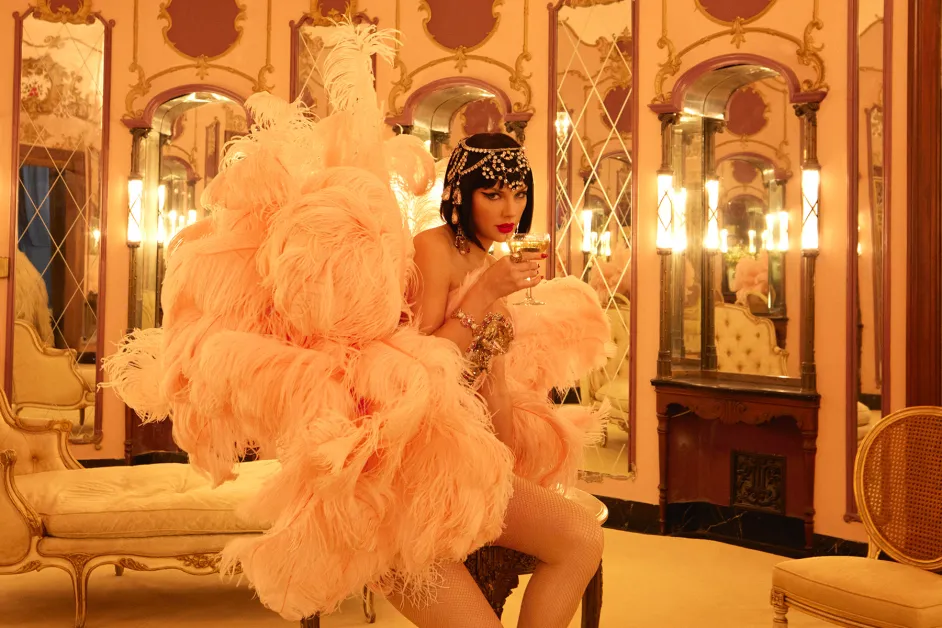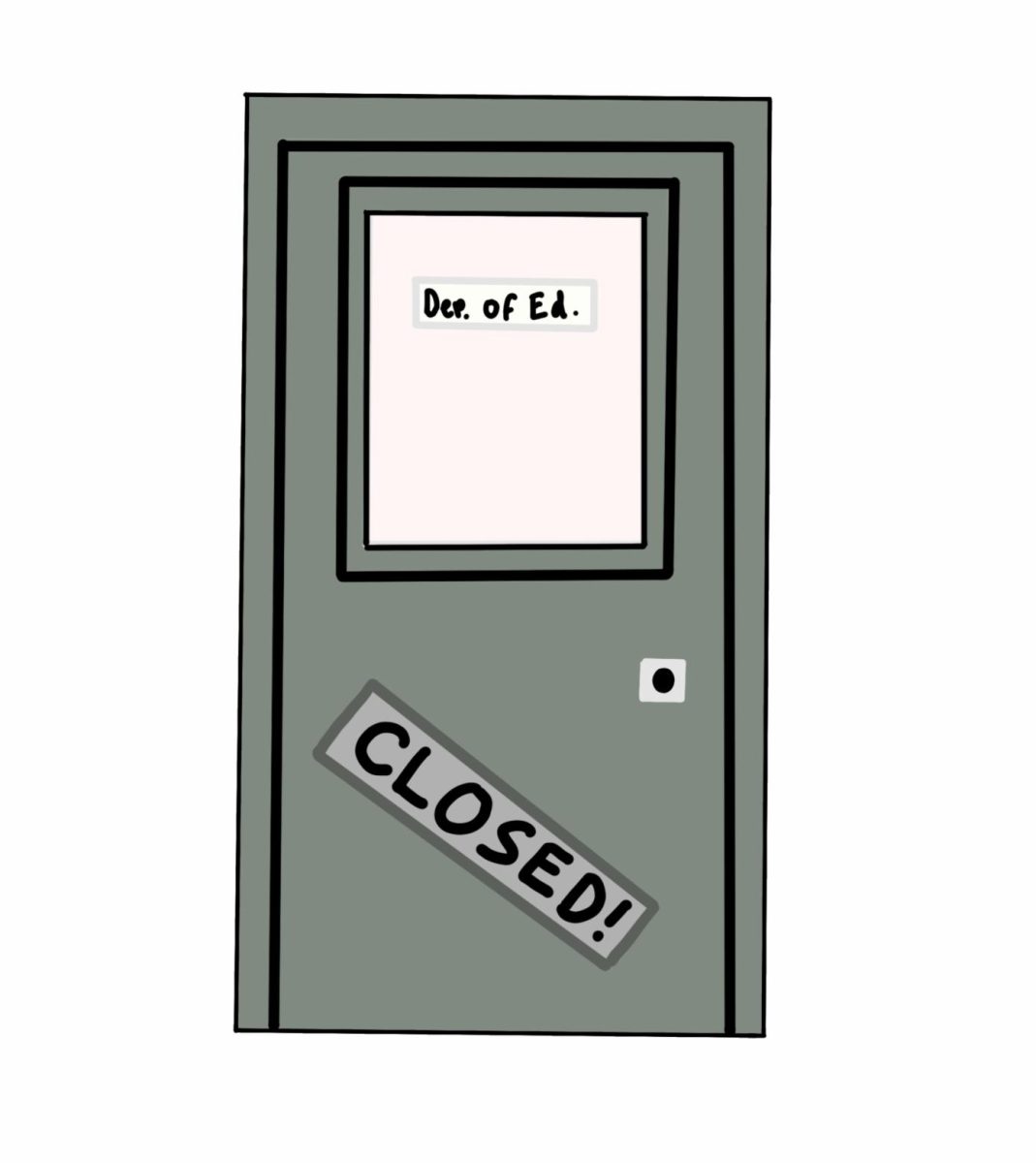What the movies taught me about high school
May 16, 2019
I’ve watched a lot of movies. I’ve seen good movies, great movies even, and many many bad movies. We’re constantly being bombarded with new movies, and it can be hard to find one that cuts through the noise. Personally, the most impactful genre of film is the coming-of-age movie, and it’s unsurprisingly so. As a high school senior, the last four years of my life have practically been a long, drawn-out coming-of-age movie — and a bad one at that.
I’ve learned a lot of lessons, some good and some bad, about high school from the movies. With high school coming to a close, I’ve been thinking a lot about what I have learned.
Lesson 1: To get the guy/girl, you have to change who you are.
I love musicals. I hate “Grease.” Long before I entered the halls of DGN, I was all too familiar with the halls of Rydell high, perhaps one of the most famous fictitious high schools. Little seven-year-old me was transfixed by my mom’s old VHS copy of “Grease.” I’ve always been a theater kid, so of course I loved the vintage costumes, the catchy music, and yes, even the dancing. But I was also a young boy, so I loved the fast car chases and the tough-as-nails T-Birds. I even dressed as Danny for Halloween in first grade. (In hindsight I was begging to be made fun of.)
As I grew up and continued to watch Grease, I eventually realized that the message of the movie was not about dancing on bleachers or fixing a sports car. Instead, the troubling message that “Grease” tried to enforce on its high school-aged audience back in 1974 was that in order to get the guy/girl, you have to fundamentally change everything about you.
Good-girl Sandy and greaser-boy Danny start the film vying for each other’s affection, but Sandy eventually finds herself on the outside of Danny’s outcast-crowd, who have a strong distaste for her. Now, instead of breaking free of their social circles’ hindrances, “Grease” suggests the best way to win your love interest’s affection is by manipulating yourself in order to appeal to their perceived social group.
Sandy ditches her poodle skirt and dons a skin-tight leather outfit, while Danny drops his hair grease and cigarette in order to join the track team. And the film tries to get us to forget about this moral compromise by distracting us with a flying car.
Lesson 2: It’s ok to be creepy, as long as you’re a dork.
Coming-of-age films subject us to a lot of men. Thankfully this trend is beginning to fade away, but many of pop-culture’s favorite movies from the eighties center on young boys, often following the nerd archetype, trying to accomplish the one thing that matters most to them — getting the girl.
Take “Sixteen Candles,” which follows the plight of the adorkable Ted who is hopelessly in love with dream girl Sam, who in turn is hopelessly in love with jock Jake. With most early coming-of-age films, characters are strictly defined by their archetype, most of which are one-dimensional and often sexist. We’re supposed to be rooting for the dork Ted instead of the jock Jake, because in the masculinity competition of mid-eighties culture, Ted is the clear underdog. “Sixteen Candles,” asks us to forgive all of Ted’s flaws and misogynistic actions just because we like to root for the underdog.
Throughout the film, Ted participates in many troubling, sexist actions. He makes a bet with his friends involving the possession of one of Sam’s undergarments. He does not take “no” for an answer when Sam clearly shows she has no interest in his romantic pursuits. He even at one point takes advantage of an inebriated girl. Instead of portraying these actions as impermissible, “Sixteen Candles” not only celebrates Ted’s actions but invites us to root for the kid merely because he has the unassuming demeanor of a friendly geek, not even to mention the film’s horribly racist stereotypes to boot. Sexist and racist? No thanks, John Hughes.
Sadly, creepy actions by geeky guys are not only limited to the coming-of-age films of yesteryear. 2010’s “Scott Pilgrim vs. The World” is no stranger to this concept. Although the rampant misogyny is toned down from a few decades ago, I find it a little disconcerting that fans are quick to forget that the film’s main character is a 22-year-old man dating a 17-year-old high school student.
The greasy garage rocker Scott Pilgrim is a different type of dork than Anthony Michael Hall’s bookish Ted, but Pilgrim’s geekiness is undisputed. Again, following the “root for the underdog” mentality that filmmakers rely on a little too much, we’re supposed to find ourselves cheering for Pilgrim because of his underperforming, underappreciated rock band (don’t get me wrong, the music is the one redeemable quality of this movie). We try to forget, or perhaps even forgive Pilgrim for being romantically involved with Knives, a girl five years his younger, because he’s still caught up in a teenage pipe dream, or because Scott is portrayed as quite immature for his age. And don’t even get me started on the manic pixie dream girl trope.
Lesson 3: When in doubt, dance it out
If all coming-of-age movies were bad, I simply wouldn’t be taking the time of day to write a way-too-long thinkpiece about them. I firmly believe that all good coming-of-age stories share one thing in common — dance.
Every good film in the genre features at least one scene where the characters cut loose and burst out in dance. Dance is perhaps the least problematic way for our troubled, angsty teens to let out their emotions other than a heart-to-heart conversation, the former being way cooler than the latter.
It’s been a staple of the genre since the beginning, I mean who can forget the dance break three-fourths of the way through “The Breakfast Club,” but it was 2012’s “The Perks of Being a Wallflower” that revitalized the ironic-yet-cool dance break. Three lovable awkward high schoolers find themselves in perhaps the most uncomfortable of locations — a school dance. Our trio of friends find themselves out of place and out of the loop with the music being played, that is until “Come on Eileen” turns on, and the rest is coming-of-age cinematic history.
Since then, “Come on Eileen” has become a staple of school dances for both wallflowers and cool-kids alike to dance to. The song’s eclectic mix of new-wave with Celtic-inspired folk tinged with unconventional vocals serves as the perfect soundtrack for an “I don’t dance I mean no way in hell” high schooler cutting loose at the big dance. The highlight of my junior year prom was hearing the opening of “Come on Eileen” and finding my friend in the middle of the crowd and subsequently dancing the hardest I’ve ever danced in my life. I’m no wallflower, but I’m no dance maniac either unless that song is playing.
Dancing in most films, especially coming-of-age classics, represents a moment where the dancer (often the protagonist) reaches a moment of self-acceptance. Isn’t that the point of the whole coming-of-age genre, to find self-acceptance? In “Perks”, the ubiquitous dance scene comes when our main character Charlie feels truly accepted by his newfound friend group. In the aforementioned “Breakfast Club,” the dance break occurs just after the scene where each of the brat-pack five reveals why they’re in detention, and their insecurities, to each other. They confide in each other, and when we see Bender, Andrew and Brian stomp their way across a library bookshelf to the aptly named “We Are Not Alone,” we feel the same sense of manic acceptance our lovable delinquents do.
The lesson I’ve taken away from these movies is that perhaps we need to dance more. Dance in the middle of the crowded dance floor. Dance in your room at 2 a.m. with your headphones in. Dance underwater, or dance in the woods. Dance yourself clean. Dance as a way to celebrate newfound self-acceptance, or perhaps a vessel to reach that, or maybe just to forget about the world for twenty minutes.
Lesson 4: Road trips will set you free.
There’s something about traveling by car that’s distinctly American. I can’t think of any other culture that romanticizes car travel as much as we do. Maybe it’s a form of escapism, we spend so much of our time stuck in cars that are not traveling, sitting stuck in traffic, that we glorify extensive travel in the same vehicle that has become our complacent captor.
My personal favorite guilty pleasure film, “Paper Towns,” based on the book by my favorite guilty pleasure author John Green, reaches its climax with a road trip. And this film is distinctly American too. What’s more American than yet another hopelessly geeky guy pining after his dream girl? Well, at least “Paper Towns” does so without all the adorkable misogyny of the eighties.
The film follows dorky Quentin (although he prefers to go by the all-so-quirky “Q”) and his infatuation with literal and metaphorical girl-next-door Margo. Margo has a habit of running away, and Q has a habit of being boring. Despite the near-cliche characters, “Paper Towns” earns my thumbs-up by cleverly avoiding the Manic Pixie Dream Girl Trope. Spoiler alert: the guy does not get the girl. Yes, the characters are built around cliches and stereotypes, but they are not defined by them. Margo is not some deeply tortured soul who is only around to make Q less boring, she’s simply a girl living her life on her own terms trying to have fun, nothing more — and she doesn’t have to be.
Enough about my shameful love for “Paper Towns,” onto the road trip. The climax of the movie comes when Q realizes that Margo is in New York (a very distinctly coming-of-age location), and has to go heroically on a road trip with his friends up the East Coast in order to “save” Margo. The protagonist and his bunch of outcast friends all pack into his mom’s minivan and depart up the coast
What I’ve learned is that no good high school experience is complete without a road trip. Spending too much time with your friends in extremely close quarters seeing America’s best cornfields and rest stops? What’s not to love?
Somehow in these movies, and certainly in “Paper Towns,” road trips symbolize a letting go of some sorts, this film’s being that Q is letting go of his obsessions over his past love interest. These trips are seen as a sort of hard reset, the unexpected solution to all our characters’ problems. Is this how it works in the real world? Perhaps not, but to be fair I’ve never been on a real road trip. Thanks to coming-of-age movies, and “Paper Towns” in particular, I think I need to steal a car.
Lesson 5: Adults are Bad, kids are Good.
John Hughes pretty much invented the coming-of-age genre. We may not like it, but it’s a fact we have to live with. Sufficient to say that Hughes has made many great films, but also some pretty darn bad ones. Lumping all of his films into two piles, good and bad, is perhaps the most fitting way to sum up his overarching thesis.
In all Hughes films, or the memorable ones at least, characters are easily divided in two ways. good and bad, young and old. It’s simple, the kids are always good people. They might be troubled, but that sense of trouble is always attributed to some underlying influence, not an inherent sense of badness. Alternatively, those above the age of 40 (as I’m writing this I now realize we rarely see anyone between the ages 20 and 39 in these types of films) are portrayed as unequivocally bad. Parents, teachers, and authority figures are written to be constantly condescending and hindrances to our teenage protagonists’ goals.
In “The Breakfast Club,” the five teenagers sitting in detention are real people with real problems, but they’re all written to be good people. Bender may be a jerk to Claire, but that’s only because of his troubled relationship with his parents. Mr. Vernon, on the other hand, is written to be a bad person with no insight as to why. He only seems to act in ways to punish our good teens and flaunt his authority.
The same can be found in “Ferris Bueller’s Day Off,” where all the adults are merely obstacles trying to ruin the fun for Ferris, who is just trying to find some last-minute solace before heading off for college and before he has to think about the Real World and before he gets lost in the banalities of day-to-day life. We, of course, sympathize with Ferris because these are all our worst fears too. We too want an escape from having to worry about what comes next, and instead, we turn to the theater instead of playing hooky.
Perhaps it makes it easier for the teenage audience to process their own emotions when their main opposing force, adults, are characterized as unequivocally bad. Dichotomies are not unnatural, it’s so much easier to see things as black and white instead of a whirlwind of greys, but it’s important to remember that all dichotomies are false dichotomies. Adults are portrayed as bad because it’s simply easier to see them that way, not because they are. We don’t want to consider the complex thoughts and motivations behind adult actions. Coming-of-age movies are a form of escapism, and not having to think about the complex moral decisions of those older and more powerful than us allows us to escape easily and with the least amount of damage possible.
Lesson 6: It’s fun to be melodramatic
Long before coming-of-age patron saint Lorde released “Melodrama,” the genre has thrust upon us character after character defined by their melodramatic ways. We’ve seen it time and time again, teenagers who care too much or care too little are thrust into compromising situations and always seem to talk in ways that no one ever does in real life.
We’ve seen 1989’s “Dead Poets Society,” where we follow boarding school students study poetry and theater and navigate pressures from parents. We’ve seen 2007’s “Juno,” where the titular character adds a sense of melodramatic charm to the world of teen pregnancy. And perhaps the best of all, we’ve seen 2017’s “Lady Bird,” where we follow a melodramatic young girl’s senior year of high school in Sacramento.
The melodrama of the coming-of-age genre often comes from taking a typical high school setting and events and placing characters who are just a little too smart in them. I mean come on, no one really talks like that. Let’s face it, it’s fun to talk like you know more than you really do, it’s fun to overreact and believe every situation is of utmost importance, it’s fun to be melodramatic.
High school is perhaps the most melodramatic time of your life. Everything matters. Every social interaction, every test grade, every second of every day is jam-packed with importance, so much so that the pressure of every such moment perhaps determining your future begins to weigh upon you. You have to cope. How? By being melodramatic.
We talk like our favorite characters because they’re cool. Juno is cool. Lady Bird is cool. We want to be like them. I wanted to be like them too, so now I write in banal melodramatic platitudes like this. Thanks a lot, Juno.
Lesson 7: High school sucks
Yes, at the end of the day, I’m still a cynical high schooler. I get up at some ungodly hour to get to deadline for the paper or to make up a test that I missed, I go to class for 8 hours, then bust my butt at whatever extracurricular activity I have after school, then go home and work on homework for a few hours, then spend whatever time I have leftover to destress, then fall asleep only to repeat over and over ad infinitum. This blows.
Coming-of-age movies rarely focus on the boring day-to-day monotony of high school, but that’s not to say they don’t showcase the negatives either. Often, the genre details a high schooler going through it, only to find some special way to escape from the banality of high school, typically by meeting a special person or finding an outlet for personal expression.
Return to “Perks of Being a Wallflower,” which, in addition to its ubiquitous dance sequence, is one of the best films the genre has to offer this side of the century. The first act of the film is characterized by Charlie absolutely hating high school. It’s his first day at a new school in a new town, and it sucks. He can’t quite fit in with anyone he talks to, he gets made fun of while walking the halls, and he has absolutely no friends. While Charlie’s loneliness might have been taken to the dramatic extreme, we all can share in his sentiments when looking back at our first days of high school.
In some ways, seeing your worst high school experiences personified on the big screen offers a sense of solace to the awkward teenager. Maybe that’s the reason these films are so compelling, or at least it’s part of the reason — to know you’re not alone in your everyday failures. We relate to these characters because, like us, they’re failable. No teenager is perfect, and neither should be our onscreen counterparts.
High school sucks, and so do we, but these films offer us the sense that that’s perfectly ok.
Lesson 8: High School is awesome
Ok, so I’m a cynical high schooler, but that doesn’t mean that I can still find a sense of optimism from time to time. High school sucks, but maybe that’s what makes it so memorable. Trying to escape from the mind-numbing horrors of pre-adult life can, in turn, deliver us some of our most cherished and plain-awesome memories.
As I’ve compiled this list of coming-of-age films for this article, I think I’ve reached a consensus that the genre peaked in 2017. Maybe that’s a very young thing for me to say, but maybe it’s true. Writer/actor/director/icon Greta Gerwig has found a way to tap the inner adolescent in all of us, it’s expressed in 2012’s understated “Frances Ha,” but it’s perhaps best done in her more recent “Lady Bird.”
Titular character Lady Bird’s life, in her eyes at least, sucks. Through her aviary viewpoint, she’s stuck in a do-nothing town belonging to a family that makes too little money, searching for some forlorn connection that may or may not really exist in middle-class Sacramento. The whole film can be characterized by Lady Bird wanting more than what she has. I think that sums it up perfectly for most of us.
We want more than what we have. No matter what we have, we will always want more. Ok, great, but what does this do with high school? Well, I’d argue that that is the essence of high school, and that’s what makes it so awesome. High school is awesome because we have all the opportunities in the world with none of the responsibilities. We can truly be whoever we want. We can be the rule-breaking slacker John Bender, or the shy awkward Charlie Kelmeckis, or the free spirit ever-absent Ferris Bueller, or the ironic romantic Juno, or even the melodramatic Lady Bird.
Or, perhaps more likely, we can be, and are, a mix of all of the above. Perhaps this is why these films resonate so soundly with us because little pieces of their respective protagonists live within us. We can try to emulate our favorite characters, to mimic their mannerisms and fashions and personalities, but we don’t have to. That’s not what these films are about. They’re about offering us someone to relate to.
High school is lonely, but as I stand on the other side looking back, I’m glad I had someone to relate to, even if only for a couple of hours.

























